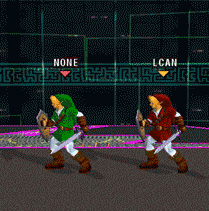Trending
Opinion: How will Project 2025 impact game developers?
The Heritage Foundation's manifesto for the possible next administration could do great harm to many, including large portions of the game development community.

Featured Blog | This community-written post highlights the best of what the game industry has to offer. Read more like it on the Game Developer Blogs or learn how to Submit Your Own Blog Post
Designing your game for Fun can lead to arbitrary rules. Players like feeling smart, so design for fun with consistent rules. Examples from Zelda & Smash Bros. reviewed.

Have you ever been stuck in a boss fight, dodging the boss's super attack and for a split second you see -- this is it -- the boss's heart (or head) is right next to you! Time to use your own super move.. and.. what? The boss is still invincible? What the hell? Then you learn (perhaps by brute trial & error) that there are several more sequences you must learn before you can hurt the boss.
At the outset, this kind of sucks, but as a player you quickly learn "Boss is invincible there".. then get to play through and enjoy the next sequence of attacks. In the end you get to look back on a tense fight where you put all of your skills carefully honed over the game's progress to the test and be proud of your accomplishment.

In many multiplayer games, recently killed players re-enter the game with "spawn invincibility", 99% of the time with no in-game fiction to support it. But players invariably understand -- it's to prevent the frustrating "spawn-killing" tactic from suceeding, where a player spawns and is immediately blasted by a fatal attack from a cunning opponent.
In both of these examples, game designers "Follow the Fun" over Consistent gameplay -- and it works, right?
Let's look at another example, where designing for Consistency results in even more fun.
People love to find solutions to problems. Game designers spend a lot of effort skillfully crafting tutorials teaching players the language of their game to empower their expression & mastery. But not every combiniation needs to be explicitly pointed out. Supporting discovery gives players "aha" moments and a deeper sense of mastery.
Take a look at the Shield mechanics of Super Smash Bros. Normally, shielding an attack protects the defending player -- allowing for an easy counter attack. This is especially common when defending against jump attacks. The attacking player hits the shield, then the ground, and is stuck watching their character tumble through a recovery animation before they can move again. Meanwhile the shielding player has plenty of time to effect their own attack. Shielding the jump in Atack is a core expression in the game's language.
But there's another level. Players who perform a Jump in Attack can tap the recovery button on landing to trigger a "Land Cancel" - instantly zeroing the attack's recovery animation. By itself this wouldn't help the attacking player, as the defender is still inside their shield. But shields have a vulnerability in the -- grabs. The shielding player is stuck inside of "hitstun" (stunned from their shield being hit by the attack), so they cannot counter or escape. The attacker hitting with a Jump in Attack then Land Cancelling has the opportunity for a free grab - breaking the opponent's shield and leading to a high damage combo situation.

Figuring this attack pattern out is a huge "aha" moment. This innovation is only possible because Super Smash Bros. offers consistent mechanics - no special protection or counter is offered to the defending player here. This forces defending players to rely on their Shield only for ground attacks against more-skilled players, evolving the metagame in an interesting fashion.
Are these forced grabs "broken"? I don't think they are -- they are a trap that rewards skilled players who know how to innovate with the mechanics. This is not "unfair", it is rewarding players who innovate with the game's consistent mechanics, just like a first person shooter player who figures out how to aim their reticule just a tad higher than normal to be at the proper plane for easy headshots.
Always design for fun. When you can keep your mechanics consistent and allow for innovation, you bring your world alive to players and offer even more fun. For more reading on this subject, checkout the Game Design Deep Dive on Titan Soul's 1-hit kill mechanic for bosses & the player.
You May Also Like